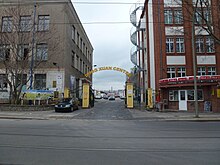| Total population | |
|---|---|
| |
| Regions with significant populations | |
| Berlin Lichtenberg, Mitte, Marzahn-Hellersdorf, Wedding, Moabit, Neukölln | |
| Languages | |
| German · Vietnamese | |
| Religion | |
| predominantly Buddhism | |
| Related ethnic groups | |
| Vietnamese people in Germany |
Vietnamese people are Berlin's largest South East Asian community, comprising 1.16% of the total population. Areas and localities with significant populations are mostly in the former East Berlin, for instance, Lichtenberg, where people of Vietnamese origin make up 11.8% of the population. Other areas with large numbers of Vietnamese are Mitte, Marzahn-Hellersdorf, and Neukölln.
As of 2014 the German Federal Foreign Office estimated that Berlin had 20,000 Vietnamese people, the largest group of East Asians in Germany. Many Vietnamese operate Spätkauf (late night convenience stores in Berlin), flower shops, and restaurants in the city.
History
In the 1980s, Vietnamese immigrants came to East Berlin as temporary contract workers (Vertragsarbeiter), as part of a deal between the East German government and the Communist government of Vietnam. South Vietnamese who fled the Vietnam War instead came to West Berlin.
Many Vietnamese remained in Berlin even though they lost their legal residence statuses and jobs after the fall of the Berlin Wall in 1989. The residence permits of other Vietnamese only permitted them to live in East Germany, even after reunification. In the 1990s many Vietnamese who lived in the now-unified Berlin began establishing small businesses. Vietnamese who lived in other parts of former East Germany, such as Chemnitz, Leipzig, and Rostock, moved to Berlin after the fall of the Berlin Wall.
Geography
As of 2014 many Vietnamese live in Lichtenberg, Marzahn, and other neighborhoods which had housing for Vietnamese contract workers during the East German era.
Ethnicity

The Vietnamese community is not a homogenous one, because one quarter of Vietnamese migrants in Berlin and Germany are Hoa (a Chinese minority in Vietnam). The rest mostly consist of Hmong and Kinh.
Economy
Dong Xuan Market in Lichtenberg is the centre of Vietnamese economic activity in the city.
The first major Vietnamese restaurant to offer Pho in Berlin was Monsieur Vuong; after its opening more Germans began patronizing Vietnamese restaurants. Prior to Monsieur Vuong's opening, Berlin restaurants operated by Vietnamese had fusion cuisine with Thai influences.
History
See also: Vietnamese people in GermanyReferences
- "Vietnamesen in Berlin | RBB Rundfunk Berlin-Brandenburg". www.rbb-online.de. Archived from the original on 28 September 2011. Retrieved 13 January 2022.
- "Archived copy" (PDF). Archived from the original (PDF) on 2014-02-03. Retrieved 2014-08-17.
{{cite web}}: CS1 maint: archived copy as title (link) - "Integrationsbeauftragte". Berlin.de. 2015-09-15. Retrieved 2016-11-19.
- ^ Grenier, Elizabeth. "Berlin's little Vietnam reflects a divided city" (Archived 2015-11-24 at the Wayback Machine). Deutsche Welle. 27 March 2014. Retrieved on 11 February 2016.
- ^ Furlong, Ray. "Hard times for Vietnamese Germans" (Archived 2016-03-02 at the Wayback Machine). BBC. Wednesday 15 February 2006. Retrieved on 11 February 2016.
- ^ Anderson, Matthew. "Berlin’s kitschy and flavourful Little Vietnam" (Archived 2016-01-26 at the Wayback Machine). BBC. 12 June 2012. Retrieved on 11 February 2016.
| Immigration to Germany | |
|---|---|
| From Europe | |
| From the Middle East | |
| From Africa | |
| From Asia-Pacific | |
| From the Americas | |
| Other | |
| Overseas Vietnamese | |
|---|---|
| Africa | |
| Americas | |
| Asia | |
| Europe | |
| Oceania | |
| Related | |